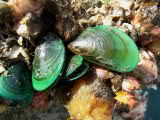 Two species of mussel are farmed for food in the country. These are : 1) The green mussel (Perna viridis, formerly Mytilus smaragdinus), and 2) The brown mussel (Modiolus metcalfeei and Modiolus philippinarum).
Two species of mussel are farmed for food in the country. These are : 1) The green mussel (Perna viridis, formerly Mytilus smaragdinus), and 2) The brown mussel (Modiolus metcalfeei and Modiolus philippinarum).
Mussel thrive best in brackish to salty water in coves, bays and estuaries. Like the oyster, the site for mussels must have enough natural food, free from pollution and sewage, protection from strong winds and waves but with enough tidal exchange.
The farm must not be too upriver as to be subject to salinity drop. And the water must be relatively deep because mussels need to be submerged all the time.
The bottom of the farm must be hard to semi-hard and sticky. A muddy-sandy substratum usually produces a high yield.
Farming methods. The farming methods for mussels are practically the same as those for oyster with some variations.
The rope-web method can be used again and again for many years. Mussels prefer the dark “hairy” and flexible polypropylene ropes as clutches. However, these are expensive. Hence, this method is not advisable for small farms, unless these farms are located where there is an abundance of larvae, and the farms operate for long period to fully utilize the durable polypropylene rope.
Polypropylene ropes of 12 mm in diameter are made into webs tied vertically to bamboo poles. A web consists of two 5 m parallel ropes positioned 2 m apart to which a 40 m rope is tied in a zigzag fashion at intervals of 40 cm between knots along each of the parallel rope.
Bamboo pegs, 20 cm long and 1 cm wide, are inserted into the zigzag rope at a spacing of 40 cm between pegs. These pegs prevent the crop from sliding down the rope when it become very heavy. The pegs also increase the surface area of the attachment of the spats.
The plot structure is the same as in the stake plot except the distance between posts is 5 m. Full-stretched rope-web- collectors are positioned 3 m apart along the rows.
In harvesting , the rope webs are united from the plot poles and lifted to the raft. Clusters of mussel are detached manually from the rope collector. The basal filaments are cut off with a sharp knife.
Washing is done by loading them in big bamboo-woven baskets (kaing or tukuyan) and dipping them repeatedly in sea water. They are then packed in synthetic sacks for transporting and marketing.
Web collector can be used again after the dirt and other foreign matters are scraped off. Drying the cleaned rope collector under the sun effectively eliminates the algae (lumot) and other organisms.
Raft method. The use of rafts in mussel farming is adapted in deeper waters. A one-unit raft may be 6 m x 8 m. It is a bamboo lattice structure from which ropes are hung. It is buoyed up by metal drums, plastic drums, styrofoam blocks or ferroconcrete buoys.
Spats are collected with the use of collector ropes. They are made of nylon with coconut husk inserted at intervals of 5-6 cm. Collector ropes, which are shorter than growing ropes, are hung on a bamboo framework 1/2 m apart. Weights are tied at the end of the ropes to prevent them from floating.
Polypropylene, polyethylene, cabo negro and abaca ropes 12- 20 mm in diameter may be used as growing ropes. Their length would depend on water depth at low tide. Bamboo pegs (25 mm long and 1.5 cm wide) are inserted into the lay of the rope at 10 cm intervals. Growing ropes are hung from the bamboo framework 1 m apart to prevent overcrowding.
MUSSEL/OYSTER: Market Guide
The market for oyster and mussel include consumers, food processors and exporters. They are usually sold by farms operators to middlemen. They are then distributed fresh (shucked or unshucked ) or salted, to retailers or consumers. Unshelled crops are sold by the basket (kaing) or by the sack. Market price are generally stable. There are instance of price fluctuations however, due to mass cropping on harvesting seasons. To ensure market stability, there should be organized cropping system.
Generally, prices in Southern Luzon are higher compared to other regions, probably because the region is the center of the demand in the country.
In Bacoor Bay, Cavite, the product is brought to the market outlets of the designating fish landing (pondahan) immediately after harvest. Bidding is usually used. Harvests in Sapian Bay, Capiz is packed in synthetic sacks air-frighten directly to Manila for retail sales.
Source: http://dost.gov.ph
Photo: blog.so-net.ne.jp
Can i ask who’s the author of this article?